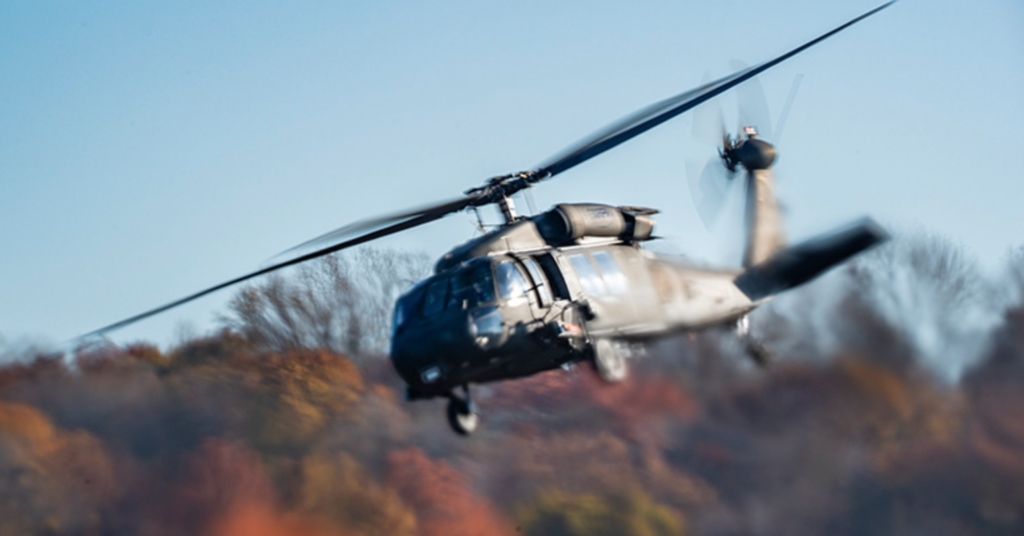
Sikorsky’s “Optionally Piloted” Black Hawk helicopter equipped with MATRIX and Rain autonomy systems during fire localization and targeting demos at Sikorsky HQ in Stratford, Connecticut.
Photo couresy of RAIN.aero
Rain.aero, a developer of aerial “wildfire containment technology” along with Sikorsky, have been for some time now researching wildfire suppression autonomous response possibilities. The companies completed test flights over a year ago with an “autonomous helicopter” that can carry and drop water onto wildfires in early stages of initial attack.
Rain — and Sikorsky — demonstrate early detection and fast response to wildfires, with an autonomous Black Hawk helicopter. The two companies have completed flight tests demonstrating how a helicopter flying with Sikorsky MATRIX and Rain’s “Wildfire Mission Autonomy System” could be quickly launched for initial attack.
The flight demonstration was at Sikorsky headquarters in Stratford, Connecticut, with the “Optionally Piloted Black Hawk helicopter” flying in autonomous mode with Sikorsky safety pilots on board.

“In 2023, in collaboration with Sikorsky, we set out to prove that we could receive an alert about a possible wildfire, send commands to launch and fly an autonomous helicopter capable of moving a large amount of suppressant to a fire’s location, and then command the helicopter to accurately drop water onto the fire,” said Rain CEO Maxwell Brodie. “We are very pleased with the results that successfully demonstrate autonomous early detection and rapid response.”
What do you think about these developments? Are you a helicopter pilot, or helitack, or hotshot or other ground crew member, or lead plane pilot or ATGS ?
I don’t know enough about the air show environment to have a first-hand opinion on pilot-free helicopters in any role on any fire. I first off can’t imagine where the pilot-free RC helicopters might even be sited (on public land? Large ranches checkerboarded with BLM 40s? Western states private timber holdings? federal or state agency land? Wilderness areas?) and how vandalism possibilities likelihoods (let alone pilot-skill vandals or cyberhacked outside operators) for pre-positioned rotorcraft of any kind (let alone a Sikorsky) might be mitigated or prevented or acted upon …

The idea makes sense, but it will probably be a bit of a cluster to make it operational. They will have to set up quite a large DROTAM or something. It would be good to launch at night for IA I guess.
My question would be how accurate is it? Can it adjust for drift? can it identify snags etc in the dip site? And since its bucketed how does it adjust to bucket movement due to turbulence/wind at the drop and if you have a good headwind at the dip your bucket will lag behind a bit going into the dip. I imagine it will be rather slow in and out of the dip, and spot drops could be tough to accomplish without either a lot of downwash on the fire or from a high altitude which will give you drift issues again.
Like I said it sounds good for night ops with nobody on the ground but once there’s personnel there you would probably want a person in the aircraft to talk tactics and make sure nobody is getting dropped on.
And I would venture to guess that a piloted helicopter will be more productive.
Until driverless cars have a PERFECT record, there should be no way a pilotless (the “unstaffed” description is a joke) aircraft should be allowed anywhere near a Fire Traffic Area. The idea that this is being advanced while driverless cars are being removed for unreliable performance is ludicrous. Is it possible in the future? Sure. Once pilotless air freighters are approved and safely flying into known highly regimented and instrumented airports, perhaps the technology has advanced enough by then for some trials. But pilotless helicopters into unknown terrain? No effing way.
When the ATGS enters the cockpit about the same time as pilotless Part 121 ( airline) ops without pilots/ aviators in the front office, there’ll be either discussion or cold sweats…
That’s hard to assess without knowing: what is the goal of having “pilot-free” helicopters fighting fire?
– Increase effectiveness in fighting fire? Broadly speaking, technology is not close to this yet. I would focus on developing autonomous capabilities for scenarios that are prohibited due to human limitations. Extreme poor visibility comes to mind. An autonomous helicopter may be able to drop water or deliver cargo in low viz that would keep pilots grounded. Using large drones for PSD operations is another good fit for replacing piloted helicopters (cost, effectiveness, and safety).
– Reduce risk to pilots? I think we’re better off continuing to develop training, policies, and oversight for flight operations and maintenance.
– Save money on paying pilot salaries? I don’t think we’re anywhere close to saving money by using pilot-less technology.
> That’s hard to assess without knowing: what is the goal of having “pilot-free” helicopters fighting fire?
Part of what they’re “selling” here is unstaffed helicopters that are fire-ready and parked at remote locations, what I was referring to when I questioned the theft/vandalism issue. Probably if you’re looking for a joy-ride (or a skyscraper kamikaze stunt) you’d not choose a read-to-fly Sikorsky, but it does beg the question …
I really can’t imagine private contractors buying this, but then RAIN is targeting agencies for buy-in and sales.
One of the “at-risk areas” they use as an illustration on their website is the area west of Sacramento and just east of Fort Bragg / Mendocino.
Staging a helicopter in a remote area, leaving it unattended for an indefinite period of time, and launching it for a mission entirely unstaffed? No, that can’t happen for numerous reasons. I think this approach could be handy for reconnaissance drones.
Whether a legit helicopter is piloted or not, it needs maintenance. And fuel. And covers to protect sensors and prevent bird’s nests in intakes, etc. I’m rusty on the FAA regs, but I believe aircraft require a mechanic’s inspection/sign off within the 72hrs prior to any flight at a bare minimum. And any airworthy helicopter (both in the physical and regulatory sense) would be expensive enough to require a secure area to protect it, whether from vandals, wildlife, or inclement weather. Also, helicopters don’t like to just sit for long periods. They develop fluid leaks and avionics malfunctions that become apparent on startup, so you would want a mechanic on site for the launch.
I don’t think launching a helicopter will ever be as easy as pressing a button in the dispatch office, if that’s the idea.